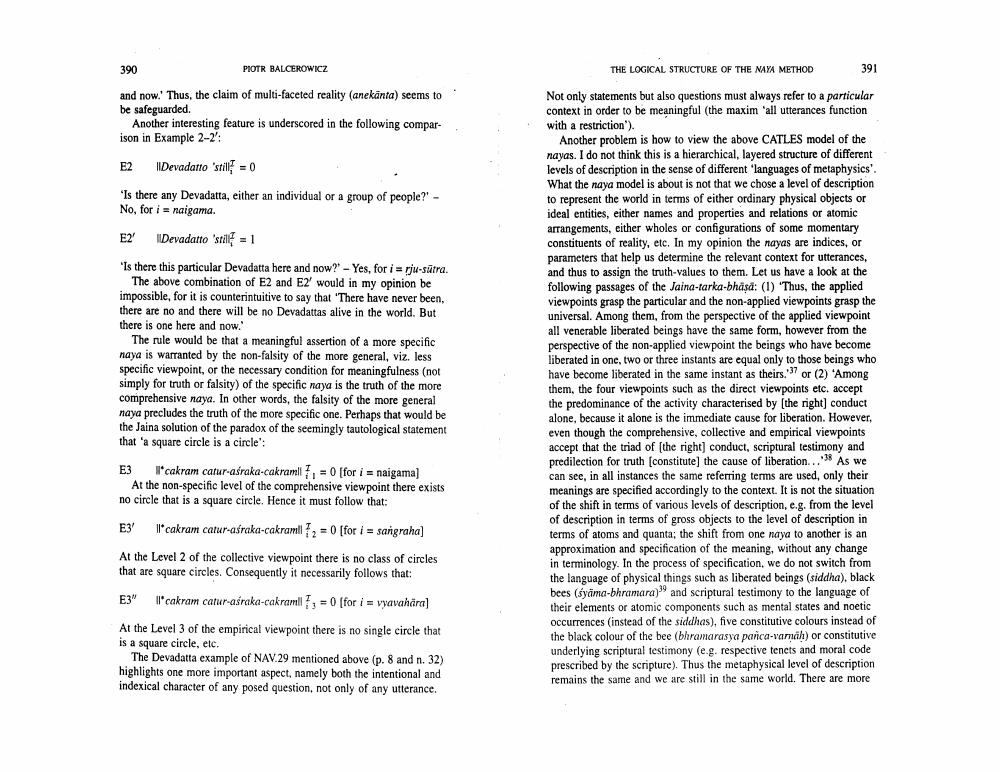Book Title: Logical Structure Of Naya Method Of Jainas Author(s): Piotr Balcerowicz Publisher: Piotr Balcerowicz View full book textPage 7
________________ 390 PIOTR BALCEROWICZ THE LOGICAL STRUCTURE OF THE MAYA METHOD 391 and now.' Thus, the claim of multi-faceted reality (anekanta) seems to be safeguarded Another interesting feature is underscored in the following comparison in Example 2-2: E2 Devadatto 'still = 0 'Is there any Devadatta, either an individual or a group of people?' - No, for i = naigama. E2 Devadatto 'still = 1 'Is there this particular Devadatta here and now?' - Yes, for i rju-sātra. The above combination of E2 and E2' would in my opinion be impossible, for it is counterintuitive to say that "There have never been, there are no and there will be no Devadattas alive in the world. But there is one here and now.' The rule would be that a meaningful assertion of a more specific naya is warranted by the non-falsity of the more general, viz. less specific viewpoint, or the necessary condition for meaningfulness (not simply for truth or falsity) of the specific naya is the truth of the more comprehensive naya. In other words, the falsity of the more general naya precludes the truth of the more specific one. Perhaps that would be the Jaina solution of the paradox of the seemingly tautological statement that 'a square circle is a circle': Not only statements but also questions must always refer to a particular context in order to be meaningful (the maxim 'all utterances function with a restriction'). Another problem is how to view the above CATLES model of the nayas. I do not think this is a hierarchical, layered structure of different levels of description in the sense of different languages of metaphysics'. What the naya model is about is not that we chose a level of description to represent the world in terms of either ordinary physical objects or ideal entities, either names and properties and relations or atomic arrangements, either wholes or configurations of some momentary constituents of reality, etc. In my opinion the nayas are indices, or parameters that help us determine the relevant context for utterances, and thus to assign the truth-values to them. Let us have a look at the following passages of the Jaina-tarka-bhäşa: (1) 'Thus, the applied viewpoints grasp the particular and the non-applied viewpoints grasp the universal. Among them, from the perspective of the applied viewpoint all venerable liberated beings have the same form, however from the perspective of the non-applied viewpoint the beings who have become liberated in one, two or three instants are equal only to those beings who have become liberated in the same instant as theirs." or (2) 'Among them, the four viewpoints such as the direct viewpoints etc. accept the predominance of the activity characterised by the right) conduct alone, because it alone is the immediate cause for liberation. However, even though the comprehensive, collective and empirical viewpoints accept that the triad of the right) conduct, scriptural testimony and predilection for truth (constitute) the cause of liberation... As we can see, in all instances the same referring terms are used, only their meanings are specified accordingly to the context. It is not the situation of the shift in terms of various levels of description, e.g. from the level of description in terms of gross objects to the level of description in terms of atoms and quanta; the shift from one naya to another is an approximation and specification of the meaning, without any change in terminology. In the process of specification, we do not switch from the language of physical things such as liberated beings (siddha), black bees (syöma-bhramara) and scriptural testimony to the language of their elements or atomic components such as mental states and noetic occurrences instead of the siddhas), five constitutive colours instead of the black colour of the bee (bhramarasya panca-vamáh) or constitutive underlying scriptural testimony (e.g. respective tenets and moral code prescribed by the scripture). Thus the metaphysical level of description remains the same and we are still in the same world. There are more E3 *cakram catur-asraka-cakramll. = 0 [for i = naigama) At the non-specific level of the comprehensive viewpoint there exists no circle that is a square circle. Hence it must follow that: E3' l* cakram catur-asraka-cakramll 2 = 0 (for i = sangraha) At the Level 2 of the collective viewpoint there is no class of circles that are square circles. Consequently it necessarily follows that: E3" "cakram catur-asraka-cakramll; = 0 (for i = vyavahara) At the Level 3 of the empirical viewpoint there is no single circle that is a square circle, etc. The Devadatta example of NAV.29 mentioned above (p. 8 and n. 32) highlights one more important aspect, namely both the intentional and indexical character of any posed question, not only of any utterance.Page Navigation
1 ... 5 6 7 8 9 10 11 12 13
